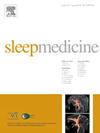Robotic beds for the treatment of positional obstructive sleep apnea – A randomized cross-over pilot trial
IF 3.8
2区 医学
Q1 CLINICAL NEUROLOGY
引用次数: 0
Abstract
Background
Interventions leading to avoidance of supine position and thus reducing the likelihood of upper airway collapse during sleep are a treatment approach for positional obstructive sleep apnea (POSA). The aim of this randomized cross-over trial was to assess the effect of two actuated beds (trunk-elevation and sideward-tilting) on OSA severity and sleep fragmentation in POSA.
Methods
After baseline polysomnography, adult patients with POSA were randomly assigned to two nights of intervention in the intelligent sleep apnea bed ISABel1 and ISABel2. In the case of obstructive apnea or hypopnea, ISABel1 elevated the upper body by 50° and ISABel2 induced a unilateral bed tilt of 40°, with both interventions lasting 10 min. Sustained trunk elevations without sliding down (ISABel1) and position change from supine to non-supine (ISABel2) were defined as successful interventions.
Results
Six adult men (57 ± 11 years, BMI 28 ± 4 kg/m2, AHI 39 ± 15/h) with POSA were included. Neither trunk elevation (ISABel1) nor side tilt (ISABel2) – approximately 10 interventions per night – significantly reduced apnea-hypopnea index (AHI), whereas trunk elevation showed a tendency to reduce supine AHI. Actuated beds had no effect on sleep efficiency and arousals. Only 13 % of side tilts in ISABel2 resulted in a successful shift to a non-supine position. The time to the next respiratory event after bed movement was longer in the trunk elevating bed than in the side-tilting bed.
Conclusion
Trunk elevating beds decrease supine AHI and both side-tilting and trunk elevating beds increase the time to the next obstructive apnea or hypopnea.
求助全文
约1分钟内获得全文
求助全文
来源期刊

Sleep medicine
医学-临床神经学
CiteScore
8.40
自引率
6.20%
发文量
1060
审稿时长
49 days
期刊介绍:
Sleep Medicine aims to be a journal no one involved in clinical sleep medicine can do without.
A journal primarily focussing on the human aspects of sleep, integrating the various disciplines that are involved in sleep medicine: neurology, clinical neurophysiology, internal medicine (particularly pulmonology and cardiology), psychology, psychiatry, sleep technology, pediatrics, neurosurgery, otorhinolaryngology, and dentistry.
The journal publishes the following types of articles: Reviews (also intended as a way to bridge the gap between basic sleep research and clinical relevance); Original Research Articles; Full-length articles; Brief communications; Controversies; Case reports; Letters to the Editor; Journal search and commentaries; Book reviews; Meeting announcements; Listing of relevant organisations plus web sites.
 求助内容:
求助内容: 应助结果提醒方式:
应助结果提醒方式:


